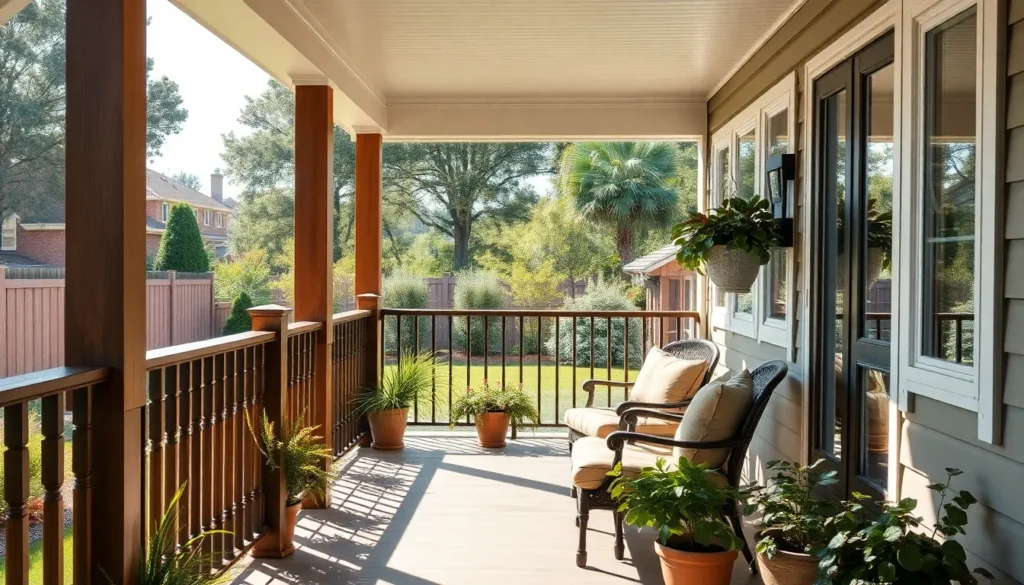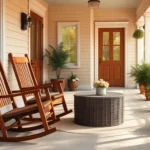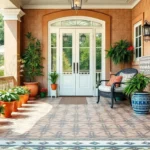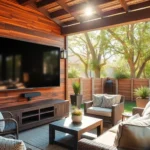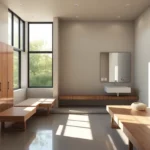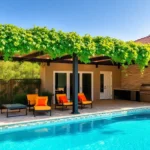We all know that back porch railings serve a crucial safety purpose, but they’re also one of the most overlooked design opportunities in our outdoor spaces. The right railing can transform your plain back porch into a stunning focal point that complements your home’s architecture while reflecting your personal style.
Whether you’re dealing with building codes that require railings or simply want to add visual interest to your outdoor area, we’ve gathered the most inspiring and practical railing ideas that’ll make your neighbors stop and stare. From budget-friendly DIY options to luxurious custom designs, there’s something here for every taste and budget.
Your back porch deserves more than just basic wooden balusters. Let’s explore creative materials, innovative designs, and smart styling tricks that’ll turn your functional railing into a true design statement that enhances your home’s curb appeal and creates the perfect outdoor retreat.
Classic Wood Railing Designs for Timeless Appeal
Wood railings remain the gold standard for back porch designs, offering versatility that complements both traditional and contemporary homes. These classic options provide the perfect foundation for creating a welcoming outdoor space.
Traditional Spindle Railings
Traditional spindle railings deliver that quintessential porch charm we all recognize from classic American homes. Vertical balusters spaced evenly between top and bottom rails create clean lines that work beautifully with colonial, Victorian, or farmhouse architecture. We recommend spacing spindles 4 to 6 inches apart for optimal safety while maintaining visual appeal.
Popular spindle profiles include turned designs with decorative grooves, square cuts for modern appeal, and chamfered edges for subtle sophistication. Cedar and pressure treated pine offer excellent durability for outdoor conditions, while mahogany provides premium longevity for higher end installations. Most homeowners find that 36 to 42 inch rail heights meet local building codes while providing adequate protection.
Rustic Log and Branch Railings
Rustic log railings bring natural woodland beauty directly to your back porch space. Full log construction using 4 to 6 inch diameter cedar or pine logs creates substantial visual weight that pairs perfectly with cabin style homes. Branch railings offer more delicate appeal, incorporating naturally curved pieces between sturdy posts for organic charm.
We suggest selecting logs with minimal bark loss to maintain authentic appearance over time. Mortise and tenon joinery provides the strongest connections for log railings, while galvanized bolts offer reliable fastening for branch designs. Local forest services often provide permits for harvesting fallen timber, making this an economical choice for DIY enthusiasts.
Painted Wood Picket Styles
Painted wood picket railings offer endless customization possibilities for expressing your personal style. White pickets create that classic cottage look, while bold colors like navy blue or forest green make striking design statements. Picket spacing typically ranges from 2 to 4 inches apart, with pointed, rounded, or decorative top cuts adding visual interest.
Horizontal picket arrangements provide contemporary flair, while traditional vertical installation maintains timeless appeal. We recommend using exterior grade primer and paint specifically formulated for outdoor wood surfaces to ensure lasting color retention. Popular picket widths include 1×3 and 1×4 boards, though 1×6 pieces create more substantial presence for larger porches.
Modern Metal Railing Solutions for Contemporary Homes
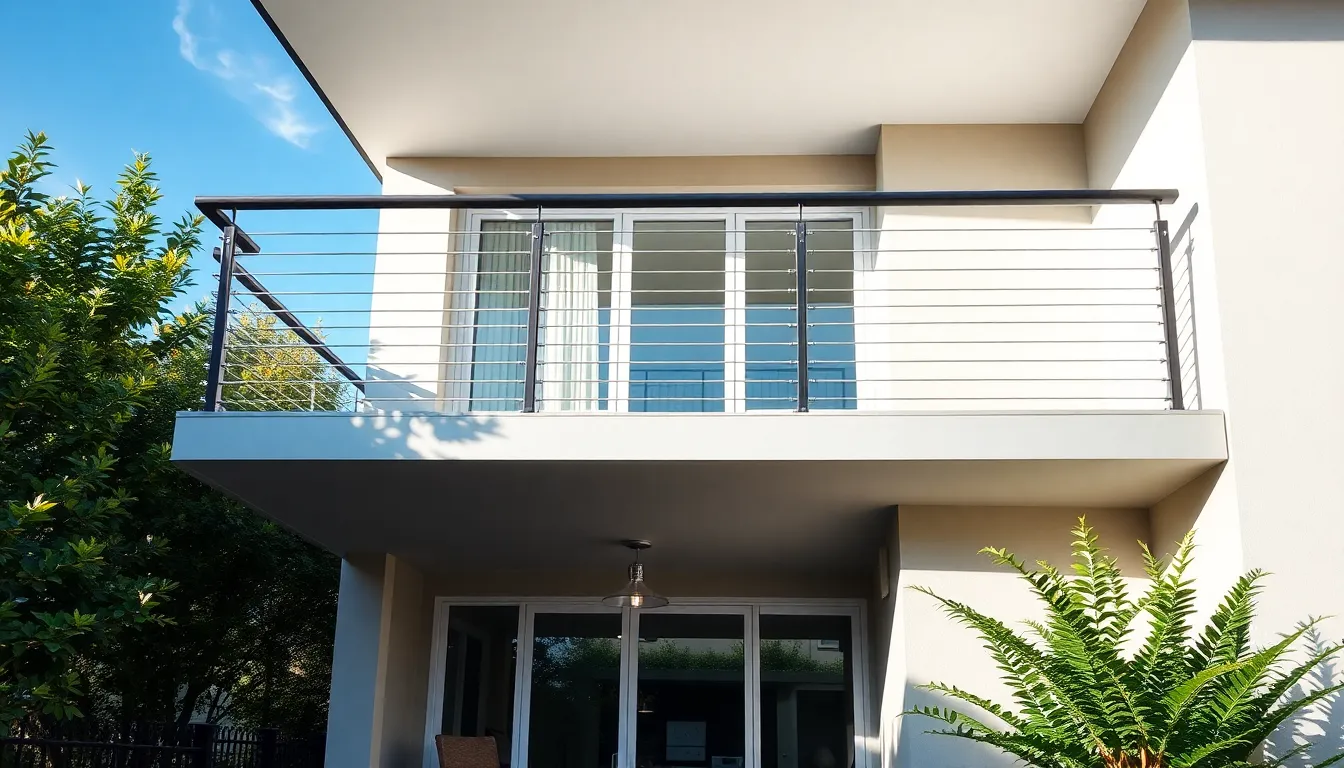
Metal railings offer the perfect blend of durability and contemporary style for today’s back porches. These sleek answers provide low maintenance options while creating striking architectural elements.
Sleek Aluminum Horizontal Railings
Aluminum horizontal railings deliver a clean, linear aesthetic that perfectly complements contemporary architecture. These powder coated systems resist weather damage and maintain their color retention for years without requiring constant upkeep. Customizable designs allow us to pair aluminum with wood or glass materials for added dimension and visual interest.
Horizontal bar configurations create an uninterrupted flow that enhances the modern appeal of any porch space. Various deck layouts can accommodate these versatile railing systems through custom sizing options. The sleek profile works particularly well with minimalist home designs where clean lines take center stage.
Industrial Black Iron Designs
Black iron railings bring bold industrial character to modern porch designs with their striking visual impact. These systems typically feature 1″ tubular metal construction with matte black powder coating that provides excellent corrosion resistance. Strong geometric patterns can be incorporated into the design or kept simple with clean lines for maximum contemporary appeal.
Minimalistic styling makes these railings perfect for homes seeking a functional yet architecturally important element. The sturdy construction ensures both safety and longevity while the dramatic black finish creates a powerful contrast against lighter exterior materials. Weather resistant coatings protect against damage while maintaining the bold aesthetic appeal.
Stainless Steel Cable Railings
Stainless steel cable systems provide unobstructed views while maintaining the safety and modern appearance we want in contemporary porch designs. Thin tensioned steel cables stretch between metal posts with optional wood or metal top rails for a mixed material approach. This open system creates an airy feel that seamlessly blends indoor and outdoor environments.
Versatile integration options allow us to combine cable railings with various post materials for elegant customization. The durable weather resistant construction requires minimal maintenance while providing years of reliable performance. Cable systems work exceptionally well for porches with scenic views where preserving sight lines is a priority.
Composite and Vinyl Railing Options for Low Maintenance
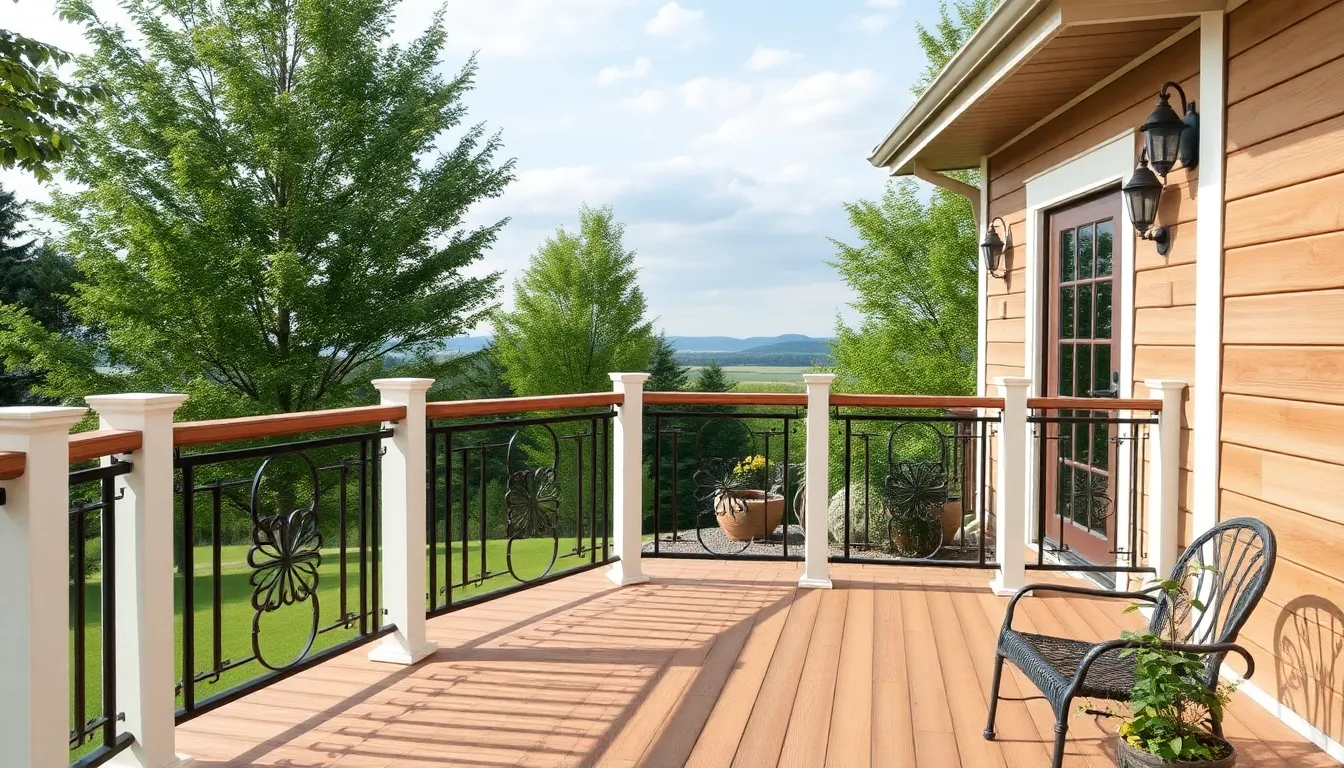
When you’re looking for beautiful railings that won’t consume your weekends with upkeep, composite and vinyl materials offer the perfect solution. These innovative materials combine stunning aesthetics with practically zero maintenance requirements.
Composite Wood-Look Railings
Composite wood-look railings deliver the warm, natural appearance of real wood without the constant maintenance headaches. These railings blend wood fibers with plastic polymers to create a material that resists rot, splintering, and insect damage while maintaining the authentic texture and grain patterns you love about wood.
We find these railings particularly appealing because they eliminate the need for annual sanding, staining, or sealing that traditional wood requires. Simply wash them with soap and water when they need cleaning, and they’ll maintain their beautiful appearance for decades.
Available styles range from classic vertical balusters to sleek horizontal designs, allowing you to customize the look for both traditional and contemporary homes. Many manufacturers offer multiple color options that mimic popular wood species like cedar, mahogany, and weathered gray, giving you flexibility to match your home’s exterior palette.
Vinyl Decorative Railings
Vinyl decorative railings excel at providing weather-resistant beauty that never needs painting or refinishing. Crafted from high-quality PVC, these railings withstand harsh weather conditions, moisture exposure, and pest damage while maintaining their pristine appearance year after year.
Color variety sets vinyl railings apart from other low-maintenance options, with manufacturers offering everything from classic white and beige to bold colors that make a statement. Decorative elements like ornate post caps, curved sections, and lattice patterns add visual interest without increasing maintenance requirements.
Installation simplicity makes vinyl railings a favorite among DIY enthusiasts and professional contractors alike. Most systems feature snap-together components or simple bracket mounting that significantly reduces installation time compared to traditional materials.
Mixed Material Composite Designs
Mixed material composite designs open up exciting possibilities for creating unique, low-maintenance railings that stand out from standard options. These innovative combinations blend the best properties of different materials while maintaining the durability and easy care that composite materials provide.
Composite posts paired with metal balusters create a modern aesthetic that offers structural strength and visual appeal. This combination works particularly well for contemporary homes where clean lines and industrial touches complement the architecture.
Glass panel inserts with composite frames deliver an upscale look that maximizes views while maintaining safety standards. These designs work beautifully for porches overlooking gardens, water features, or scenic landscapes where you don’t want to obstruct the view.
Cable components integrated with composite rails provide a striking contrast that adds sophistication to any porch design. This hybrid approach combines the sleek appearance of cable railings with the durability and low maintenance of composite materials, creating a truly custom look that requires minimal upkeep.
Glass Panel Railings for Unobstructed Views
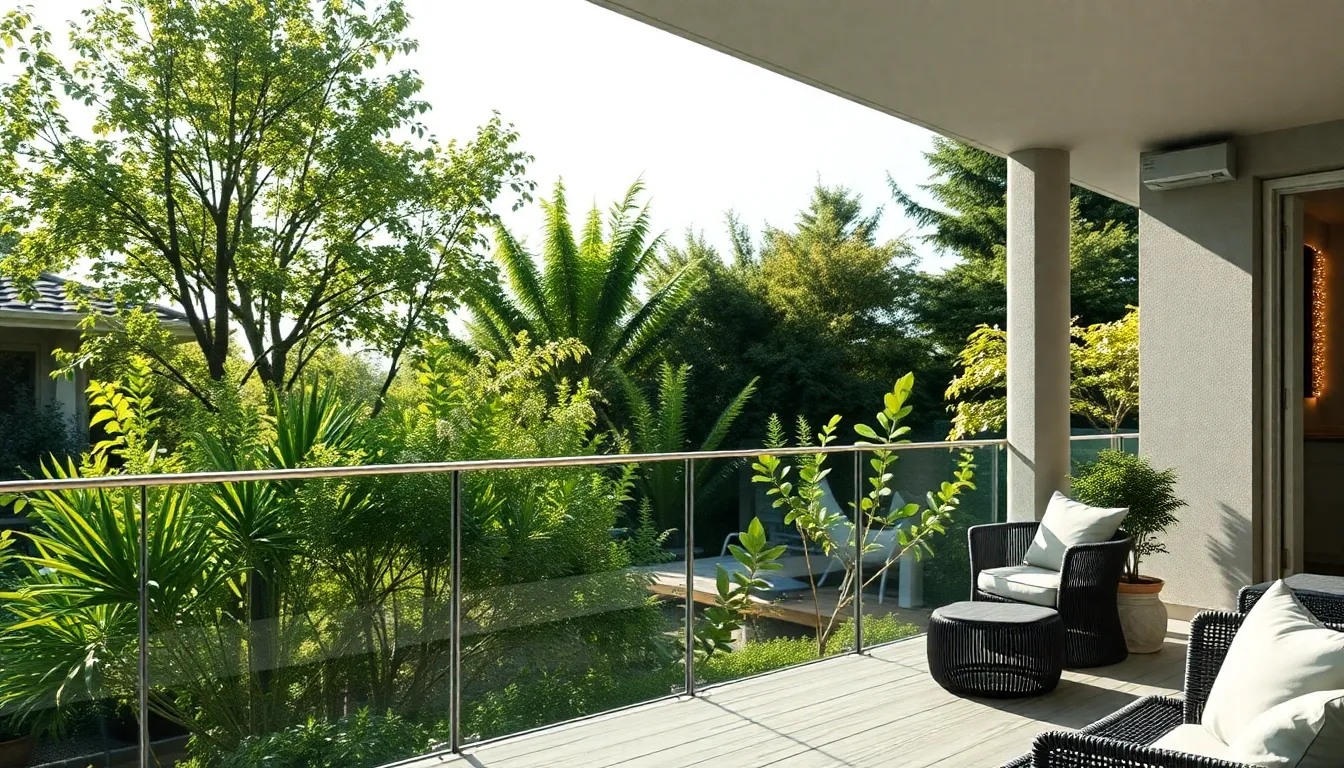
Glass panel railings transform your back porch into an open viewing platform where scenic vistas remain completely visible. These transparent barriers combine safety with style while maintaining the connection between your outdoor space and surrounding industry.
Tempered Glass with Metal Frames
Tempered glass panels offer exceptional durability through heat treatment that makes them four times stronger than regular glass. We recommend pairing these safety glass panels with slim aluminum or stainless steel frames that provide structural support without overwhelming the design. Metal frames can be powder-coated in various colors to complement your home’s exterior while maintaining their weather resistance.
Installation typically involves securing the glass panels within the metal framework using specialized glazing systems. Aluminum frames are particularly popular because they’re lightweight and corrosion-resistant, making them ideal for coastal environments. Stainless steel options provide an ultra-modern appearance that works well with contemporary architecture.
Safety codes require railings to prevent openings larger than 4 inches, which tempered glass easily satisfies while offering peace of mind for families with children. The combination creates a sophisticated barrier that enhances rather than detracts from your porch’s visual appeal.
Frameless Glass Railing Systems
Frameless glass railings eliminate visual barriers entirely by using minimal hardware to secure panels at their base. These systems rely on structural glazing techniques and discrete clamps that virtually disappear from view. We’ve seen these installations create stunning effects on porches with mountain, water, or garden views.
Base-mounted systems anchor the glass panels directly to the porch structure using hidden brackets. Top rails become unnecessary when glass panels meet proper height requirements and structural engineering standards. This approach delivers the cleanest possible sightlines while maintaining required safety barriers.
Professional installation is essential for frameless systems because they require precise measurements and specialized mounting hardware. The result justifies the investment with truly uninterrupted panoramic views that make your porch feel like an extension of the industry beyond.
Tinted and Frosted Glass Options
Tinted glass panels reduce glare and solar heat while maintaining transparency for comfortable outdoor living. Bronze, gray, and blue tints are popular choices that complement different architectural styles while providing UV protection. We find these options particularly beneficial for west-facing porches that receive intense afternoon sun.
Frosted glass creates privacy without sacrificing natural light, making it perfect for porches near neighboring properties or busy streets. Sandblasted finishes offer subtle texture while acid-etched surfaces provide smooth, easy-to-clean alternatives. Custom patterns and designs can be incorporated into frosted panels for decorative elements.
Both tinted and frosted options integrate seamlessly with framed or frameless mounting systems. Smart glass technology even allows panels to switch between clear and opaque states electronically, though this premium option requires electrical connections and specialized controls.
Natural Stone and Brick Railing Ideas
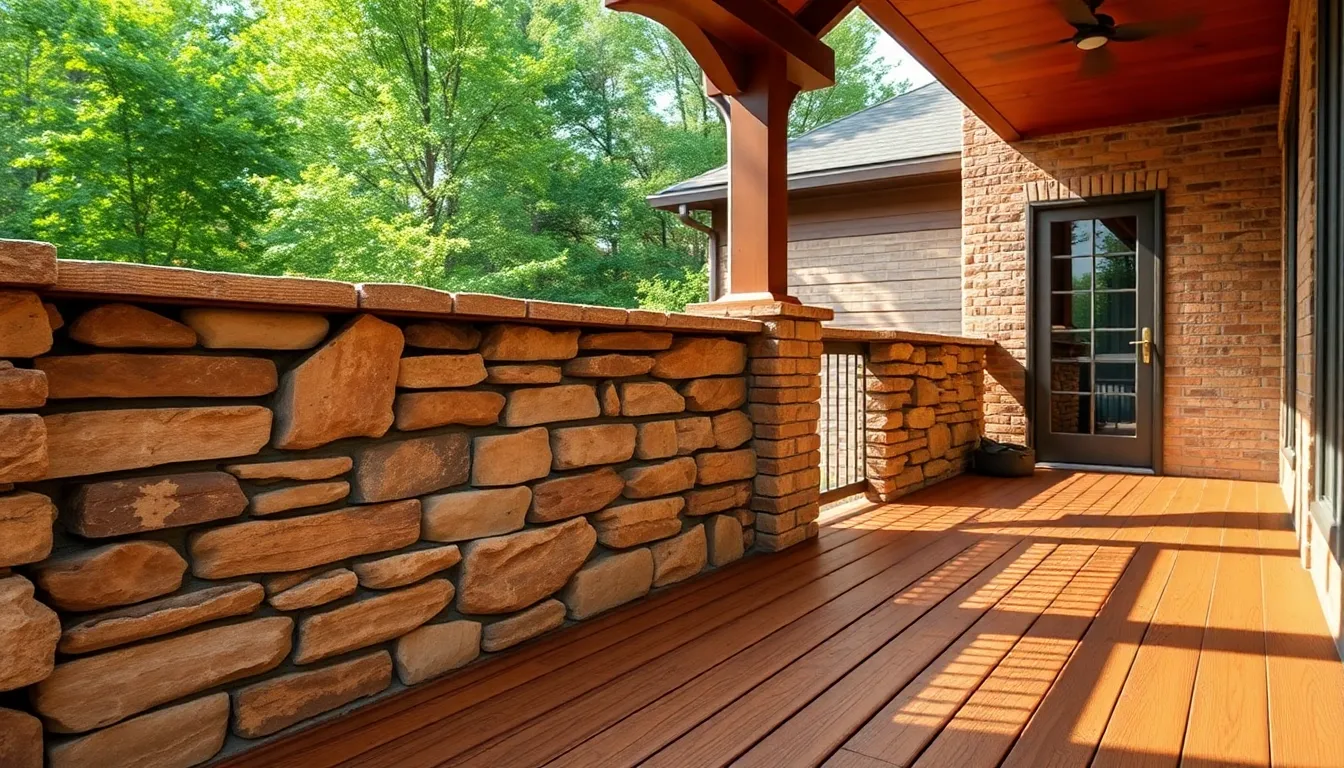
Natural stone and brick railings bring timeless elegance and durability to back porches while requiring minimal maintenance. These masonry options offer weather resistance and complement landscaping beautifully.
Stacked Stone Pony Walls
Stacked stone pony walls create low barriers around your porch perimeter using natural materials like slate, sandstone, or limestone. These walls stack horizontally to form rustic, solid boundaries that don’t completely obstruct views. Natural stone textures and colors add warmth and character to your outdoor space while providing sturdy protection.
We love how these walls blend seamlessly with outdoor surroundings, creating an organic transition between your porch and industry. You can top them with wood or metal rails for additional safety and style enhancement. The horizontal stacking pattern creates visual interest while maintaining the natural aesthetic that makes these walls so appealing.
Brick Column Railings
Brick column railings combine traditional masonry with wood, metal, or wrought iron elements to create elegant porch boundaries. These columns serve as anchor points for railings, delivering a stately appearance that’s perfect for Craftsman style or traditional homes. Structural stability comes naturally with brick construction, allowing you to space columns evenly with complementary balusters.
Decorative brick patterns and caps can add architectural interest to your design. The balance between brick’s solidity and the openness of wood or metal balusters creates visual appeal without feeling heavy. This combination works particularly well when you want to maintain sight lines while establishing clear boundaries.
Natural Rock and Mortar Designs
Natural rock and mortar railings use rounded or irregularly shaped stones set in mortar to create organic, handcrafted boundaries. This approach emphasizes earthy textures and natural colors that work beautifully in rural or nature inspired settings. Mortar holds stones firmly while allowing you to customize height and thickness based on your exact needs.
These designs can incorporate wooden handrails or metal accents to add functionality while preserving the natural aesthetic. The irregular stone shapes create unique patterns that make each installation one of a kind. Contemporary variations might combine stone bases with cable, metal, or glass panels to maintain open views while ensuring safety compliance.
Creative DIY Back Porch Railing Projects
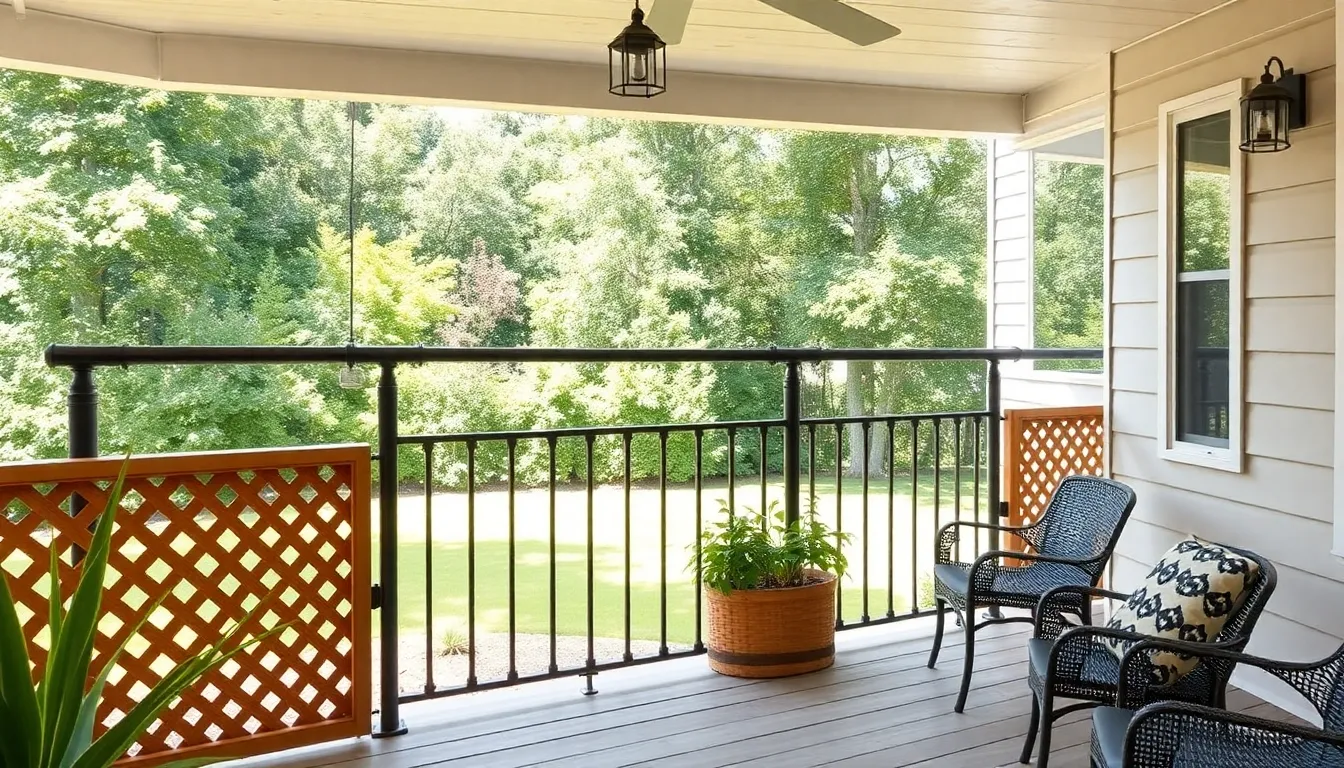
Transforming your back porch with DIY railing projects opens up endless possibilities for creativity while keeping costs manageable. These customizable answers let you express personal style through unique material combinations and innovative design approaches.
Repurposed Material Railings
Environmentally conscious homeowners are discovering the beauty of repurposed materials for creating distinctive porch railings. Metal pipes combined with unstained cedar box sections create an eye-catching blend of rustic charm and modern aesthetics that catches attention from every angle. Reclaimed wood offers character that new materials simply can’t match, bringing history and texture to your outdoor space.
Wrought iron pieces salvaged from old buildings or fences can be transformed into stunning decorative railings with proper cleaning and restoration. Adding stained glass inserts between metal sections creates artistic focal points that filter light beautifully throughout the day. Glass panels from old windows or doors provide transparency while maintaining safety standards when properly installed in sturdy frames.
Creative builders are incorporating everything from vintage farm equipment to architectural salvage into their railing designs. These unique materials reduce waste while creating conversation pieces that reflect personal interests and local history.
Decorative Lattice Patterns
Lattice designs bring timeless elegance to back porch railings while offering practical benefits like partial privacy and improved airflow. Traditional diamond patterns create classic appeal that complements both colonial and contemporary home styles seamlessly. Square lattice arrangements offer a more structured appearance that works particularly well with modern architectural elements.
White lattice paired with matching posts and handrails remains a popular choice for its crisp, clean appearance that brightens outdoor spaces. Custom lattice patterns can incorporate varying spacing or decorative cutouts to create visual interest while maintaining the classic aesthetic. Combining lattice panels with solid wood sections provides the perfect balance between openness and privacy.
Maintenance becomes easier when lattice panels are designed as removable sections that can be taken down for cleaning or seasonal storage. Strategic placement of lattice elements can also help define different areas of larger porches while maintaining visual continuity.
Combination Wood and Wire Designs
Modern homeowners are embracing wood and wire combinations that create sleek, contemporary railings with unobstructed views. Wooden posts anchored with thin vertical metal cables allow clear sightlines to landscaping while ensuring safety compliance. Horizontal cable arrangements offer a different aesthetic that emphasizes the linear aspects of modern architecture.
Multiple cable strands topped with smooth wood rails create sophisticated finishes that complement natural landscapes beautifully. Stainless steel cables resist weather better than traditional materials while requiring minimal maintenance beyond occasional cleaning. Cedar or treated lumber posts provide warm contrast against sleek metal elements.
Installation becomes straightforward with proper tensioning hardware and pre-drilled posts that accommodate cable routing. Regular wood maintenance through staining or sealing preserves the natural beauty while protecting against moisture damage. These designs work particularly well on elevated porches where views are premium considerations.
Budget-Friendly Railing Alternatives

We’ll explore cost-effective railing answers that deliver style without breaking your budget. These affordable alternatives prove you don’t need expensive materials to create stunning back porch railings.
Rope and Post Railings
Rope and post railings deliver a nautical aesthetic while keeping costs minimal. We install sturdy posts made from wood or metal around the porch perimeter, then string thick rope horizontally between them. This design creates an open, airy feel that’s perfect for casual, beach-themed, or farmhouse-style porches.
Installation becomes straightforward with this system since you’ll need fewer materials than traditional balusters. The rope adds texture and visual interest while maintaining durability with minimal maintenance requirements. We find this option significantly cheaper than glass or metal alternatives while still providing the safety barrier your porch needs.
Bamboo Screen Railings
Bamboo screen railings offer sustainable beauty at budget-friendly prices. We attach bamboo poles vertically or horizontally within simple wood or metal frames to create natural, tropical aesthetics. This lightweight material assembles easily and provides privacy alongside decoration.
Fast-growing bamboo remains widely available, making it an economical choice for environmentally conscious homeowners. You can combine bamboo with other materials to create unique looks that suit your personal style. We recommend this option for those seeking eco-friendly alternatives that don’t compromise on visual appeal.
Reclaimed Wood Options
Reclaimed wood transforms salvaged materials into charming porch railings with character. We repurpose old barn wood, pallet wood, or demolition salvage to create rustic boundaries that tell stories. This environmentally friendly approach significantly reduces costs compared to new hardwoods or manufactured products.
Weathered textures and aged colors add unique beauty while reducing waste in landfills. You’ll invest some DIY effort to prep and finish these materials, but the cost savings make it worthwhile. We find reclaimed wood railings particularly suited for farmhouse, cottage, or rustic home styles where authentic character matters most.
Safety Considerations and Building Code Requirements
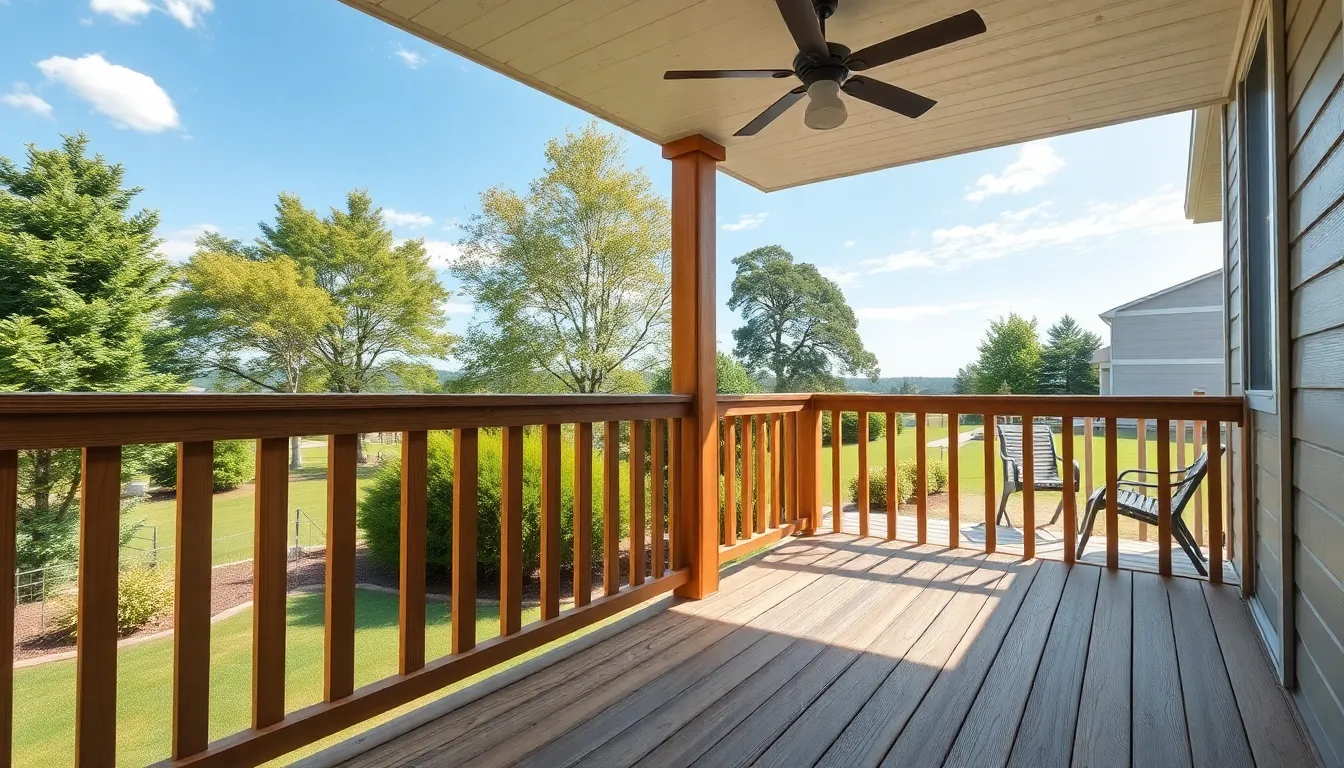
Beautiful railing designs mean nothing if they don’t protect your family and comply with local building codes. We’ll explore the essential safety requirements that every back porch railing must meet.
Height and Spacing Regulations
Building codes require porch railings to maintain a minimum height of 36 inches from the deck surface to the top rail. This standard comes from the International Residential Code and applies across most U.S. locations. California and several other states mandate even taller railings at 42 inches or higher.
Spacing between balusters cannot exceed 4 inches to prevent children from slipping through dangerous gaps. We must ensure the gap between the deck surface and bottom rail stays under 4 inches as well. Deck stairs require special attention since triangular spaces formed by treads, risers, and bottom rails must block any sphere larger than 6 inches.
Load-Bearing Requirements
Railing systems must withstand exact loads to ensure family safety during normal use. Guardrails need to handle at least 125 pounds per linear foot applied horizontally or vertically across their length.
Top rails must support concentrated loads of 500 pounds at critical points like mid-span areas, post sides, and directly on top of posts. Balusters and infill panels require resistance to 125 pounds applied over one square foot of surface area.
Engineers build these requirements with a safety factor of 2.5, meaning actual design loads get multiplied by 2.5 to guarantee long-term durability and protection.
| Load Type | Requirement | Application |
|---|---|---|
| Uniform Load | 125 lbs per linear foot | Horizontal/vertical on guardrails |
| Concentrated Load | 500 lbs point load | Top rail at mid-span and posts |
| Infill Load | 125 lbs per sq ft | Balusters and panels |
| Safety Factor | 2.5x design load | All structural calculations |
Proper Installation Guidelines
Posts require spacing no greater than 8 feet apart to maintain structural integrity and meet strength standards. We recommend using outdoor-rated hardware and fasteners capable of handling required loads.
Anchoring systems must secure railings directly to the deck’s structural framework rather than just surface boards. Engineered railing systems should carry testing certifications proving compliance with IRC and International Building Code standards.
Local building inspectors often require stamped engineering plans for custom railing designs that fall outside prescriptive code guidelines. This ensures your unique design meets or exceeds performance standards for your exact installation conditions.
Conclusion
Your back porch railing doesn’t have to be an afterthought. With countless design possibilities spanning traditional wood to modern metal systems we’ve explored creative answers that match every style preference and budget constraint.
Remember that the best railing combines visual appeal with essential safety features. Whether you’re drawn to DIY rope installations or elegant glass panels the key lies in selecting materials that complement your home’s architecture while meeting local building codes.
We encourage you to experiment with different textures colors and combinations to create a unique outdoor space. Your back porch railing can become a stunning focal point that enhances both your home’s curb appeal and your daily enjoyment of outdoor living.
Frequently Asked Questions
What are the main benefits of installing back porch railings?
Back porch railings serve dual purposes: safety and design enhancement. They prevent accidents by creating barriers around elevated areas while significantly improving your outdoor space’s aesthetic appeal. Quality railings can reflect your personal style, increase property value, and transform a basic porch into an attractive outdoor retreat that complements your home’s architecture.
What are the most popular materials for back porch railings?
The most popular materials include wood (traditional and versatile), metal (aluminum, iron, stainless steel), composite and vinyl (low-maintenance), glass panels (modern and sleek), and natural stone or brick (timeless elegance). Each material offers different benefits in terms of durability, maintenance requirements, cost, and aesthetic appeal to suit various home styles and budgets.
What are the basic safety requirements for porch railings?
Building codes typically require railings to be at least 36 inches high with baluster spacing no greater than 4 inches apart to prevent falls. Railings must meet specific load-bearing requirements to withstand certain weights. Proper installation includes appropriate post spacing and outdoor-rated hardware. Always check local building codes for specific requirements in your area.
Can I install porch railings myself or do I need a professional?
Many railing systems are designed for DIY installation, especially simpler designs like rope and post or basic wood railings. However, complex installations, custom designs, or those requiring structural modifications may need professional installation. Consider your skill level, local building codes, and safety requirements when deciding between DIY and professional installation.
What are some budget-friendly railing options?
Budget-friendly options include rope and post railings for a nautical look, bamboo screen railings for sustainable privacy, and reclaimed wood designs that repurpose salvaged materials. DIY projects using repurposed materials like metal pipes or decorative lattice patterns can also provide significant cost savings while creating unique, personalized designs.
How do I choose the right railing style for my home?
Consider your home’s architectural style, personal preferences, budget, and maintenance requirements. Traditional homes often suit wood spindle or brick column railings, while contemporary homes work well with metal, glass, or cable railings. Think about the view you want to maintain, privacy needs, and how the railing will complement your existing outdoor decor.
What maintenance do different railing materials require?
Wood railings need regular staining or painting and periodic inspection for rot or damage. Metal railings may require rust prevention treatments. Composite and vinyl options need minimal maintenance—just occasional cleaning. Glass panels require regular cleaning for clarity. Stone and brick are very low-maintenance but may need occasional pointing or sealing.
Are there eco-friendly railing options available?
Yes, several eco-friendly options exist including bamboo railings (rapidly renewable resource), reclaimed wood designs (repurposes existing materials), and composite materials made from recycled content. These options reduce environmental impact while providing attractive, functional railings that can match various design preferences and budgets.

